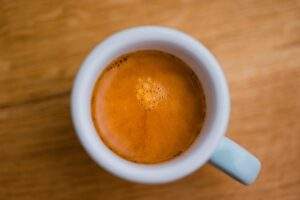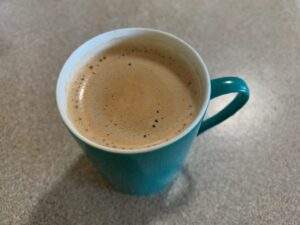Last Updated on 12/02/2023 by Miki
Table of contents
Have you ever made an espresso and noticed that there was no crema on the surface? NO CREMA ON ESPRESSO! If so, you’re not alone. Many baristas and coffee aficionados alike have experienced this issue at one point or another. Whenever this happens, it makes me extremely disappointed as I would love to enjoy beautiful crema every single time! But what exactly is causing “no cream on espresso?” Well, more importantly, how do you fix it? In this blog post, we’ll discuss the common causes of this issue and provide you with some helpful tips on how to get that perfect crema on your espresso shots. So, let’s get started!
What Is Crema On Espresso?

Crema on espresso is the thin layer of golden-brown foam that sits on top of a freshly brewed cup of espresso. It is comprised of two things: the oils from the coffee bean, and the dissolved gases that are released from the coffee grounds during extraction. The resulting crema has a sweet and nutty flavour that adds complexity and depth to the espresso drink. It also acts as a protective barrier, keeping the espresso drinker from tasting the bitterness of over-extracted coffee grounds.
Why Is There No Crema On Espresso?
1. Not Ground Fine Enough: Espresso needs to be ground fine in order for crema to form. If the espresso is not ground fine enough, it will not have enough surface area to capture and stabilise the espresso’s natural oils and produce crema.
2. Inadequate Pressure: Crema requires a certain level of pressure to form. If the pressure used by an espresso machine is too weak, crema will not form regardless of how finely the coffee is ground.
3. Inadequate Extraction Time: If the brewing process does not take long enough for all of the natural oils to be extracted from the coffee grounds, then there will be no cream.
4. Low Water Temperature: For a good espresso, the water temperature needs to be around 196-205 degrees Fahrenheit/91-96 degrees Celsius. If the water is too cold, you won’t get enough extraction and thus, no crema.
5. Poor Quality Coffee: Low-quality coffee has less of the oils that form the crema. So, even with proper grinding, extraction time and pressure, if the coffee is of poor quality it may not have enough oils to create crema.

How To Get Crema On Espresso
1. Begin by grinding high-quality espresso beans. Make sure the grind is set to a fine texture, similar to that of granulated sugar.
2. Measure out the freshly ground beans into the portafilter.
3. Distribute and tamp the espresso grinds evenly with a tamper, applying appropriate pressure.
4. Place the portafilter in the group head of the espresso machine and lock it into place.
5. Press the start button and wait for the espresso shot to be pulled. This process should take approximately 20-25 seconds.
6. Once the espresso shot is pulled, you should begin to see a light golden layer of crema forming at the top of the shot. This is a sign that your espresso shot is ready!
How To Get More Crema On Espresso

1. Use fresh, high-quality beans: Using fresh, high-quality beans that are suitable for espresso will provide the best chance of producing a thick crema.
2. Grind the beans freshly: Prior to brewing, grind your beans freshly, ideally right before you brew the espresso. Espresso should be brewed with a fine grind as if you are making flour. Avoid pre-ground coffee since it tends to produce a more watery espresso, leading to a weaker crema.
3. Have the right espresso machine and accessories: Having the right espresso machine and accessories can make all the difference in creating a great cup of espresso with a thick crema.
4. Use mineral water: Use mineral water instead of tap water for brewing espresso since it can help create more crema. Mineral water typically contains more minerals and has lower acidity than tap water.
5. Use the correct espresso dose: Depending on the size of your portafilter basket, you can use anywhere between 7 and 20 grams of ground coffee for a double-shot espresso. A good starting point is 14 grams, which is enough to fill a standard double-shot portafilter basket.
6. Consider temperature: In addition to proper dosing, temperature also plays a vital role in producing crema. Make Ensure your espresso machine maintains a consistent temperature while brewing, as any discrepancies may lead to weak crema production.
How To Get Less Crema On Espresso
1. Use a higher dose of coffee: A higher dose of coffee beans will result in less crema because the lower density of the beans will create less pressure and therefore, less extraction from the espresso.
2. Use coarser grinds: If you want to get less crema on espresso, a coarser grind can help. This grind size allows more air and steam to pass through the grounds while they are being extracted.
3. Increase water temperature: Using a higher water temperature can speed up the extraction rate, making it more difficult to get the crema that is desired in an espresso shot.
4. Increase tamping pressure: Increasing the tamping pressure can also reduce crema production, as it makes it more difficult for the pressurized water to pass through the coffee grounds.
5. Use well-aged or pre-ground beans: The oils in stale coffee beans don’t produce as much crema as freshly ground coffee.
Final Thoughts
In conclusion, if you find that your espresso is lacking crema there are a few methods that you can try to fix it. First and foremost, the quality of your coffee beans matters the most and having high-quality coffee beans with a finer grind will produce the most amount of crema. If you have already invested in high-quality coffee beans, try playing around with different grind sizes and tamping techniques to get the right mix. Lastly, don’t forget to clean and maintain your espresso machine on a regular basis as this will also help keep your espresso crema looking its best.

